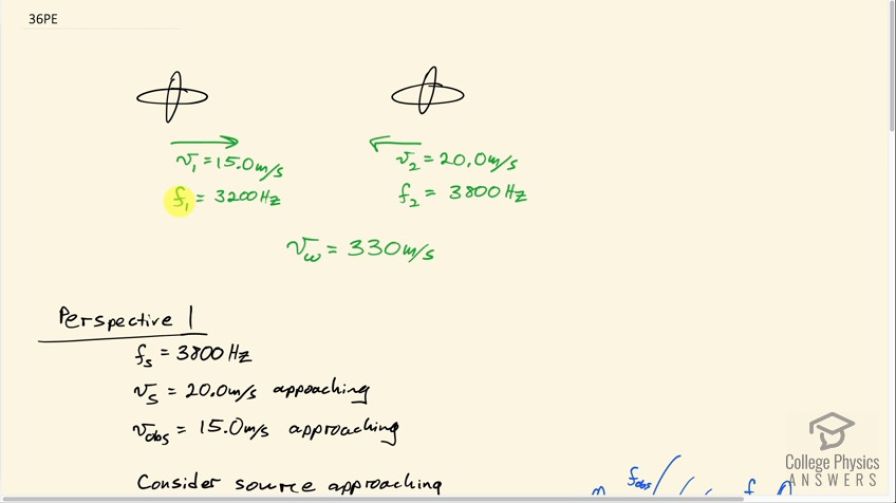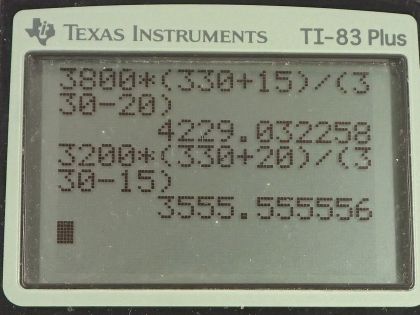Question
Two eagles fly directly toward one another, the first at 15.0 m/s and the second at 20.0 m/s. Both screech, the first one emitting a frequency of 3200 Hz and the second one emitting a frequency of 3800 Hz. What frequencies do they receive if the speed of sound is 330 m/s?
Final Answer
Frequency observed by the first eagle:
Frequency observed by the second eagle:
Solution video
OpenStax College Physics for AP® Courses, Chapter 17, Problem 36 (Problems & Exercises)

vote with a rating of
votes with an average rating of
.
Calculator Screenshots
Video Transcript
This is College Physics Answers with Shaun Dychko. Two eagles are approaching each other: this first eagle is moving at 15.0 meters per second and emits a frequency of 3200 hertz; the second eagle is approaching at 20.0 meters per second and emits a frequency of 3800 hertz and the speed of sound we are told is 330 meters per second. So the question is which each frequency will each eagle perceive from the other eagle? So let's consider perspective of this first eagle that's moving at 15.0 meters per second and the frequency of the source from that perspective is the frequency emitted by the second eagle— 3800 hertz— and the speed of the source is 20.0 meters per second and the speed of the observer, which is eagle 1, is 15.0 meters per second and both of these are approaching. So first we'll consider the fact that the source is approaching the observer and this formula assumes that the observer is stationary which of course is not true in this question but we'll just use it for the time being and then deal with the fact that the observer is moving in the second part here. Okay! So we have this source emitting a source frequency and that frequency will reach this first eagle as f s times the speed of sound divided by the speed of sound minus the speed of the source. Now because the observer is approaching the source, we have to also use this formula which says that the frequency emitted by the source is multiplied by the speed of sound plus the speed of the observer divided by the speed of sound. And we have this plus here because when the observer is approaching the source, we would expect the frequency observed to be higher than the frequency emitted by the source and having a plus sign here increases the numerator and therefore makes this fraction greater than 1 and multiplying the source frequency by a number greater than 1 causes the observed frequency to be greater than the source frequency as we expect. Now this source frequency in this equation is not 3800 hertz because the source is approaching and so this f s prime is actually this result here... this frequency observed by a hypothetically stationary observer is the source frequency that we consider for this equation where the observer is approaching. So we substitute f s times v w over v w minus v s in place of f s prime. So this speed of sound cancels here and we are left with this formula so when we have an observer and source approaching each other, the observed frequency will be the source frequency multiplied by the speed of sound plus the speed of the observer divided by the speed of sound minus the speed of the source. And both of these modifications to the speed of sound—a plus in the numerator and a minus in the denominator— both of those things have the effect of increasing this fraction. So by reducing the denominator, we increase the quotient and by increasing the numerator, we increase the quotient both of which give the expected result of increasing the observed frequency. So we have 3800 hertz times 330 meters per second plus 15.0 meters per second— the speed of the observer moving towards the source so that's speed 1 in other words— divided by 330 meters per second minus 20.0 meters per second— minus the speed of the source v 2 you could say— and this works out to 4.23 times 10 to the 3 hertz. Now from the perspective of the second eagle, we are gonna repurpose this same formula. So the final observed frequency, f prime, observed from the perspective 2 equals the source frequency from the perspective 2 and that is f 1 in other words. So the source being the first eagle now and we multiply that by the speed of sound plus the speed at which the observer is moving which is 20.0 meters per second divided by the speed of sound minus the speed of the source from the perspective 2 and the source from this eagle's perspective the source is eagle 1 and it's moving at a speed of 15.0 meters per second. So we have 3200 times 330 plus 20.0 divided by 330 minus 15.0, this works out to 3.56 times 10 to the 3 hertz.
